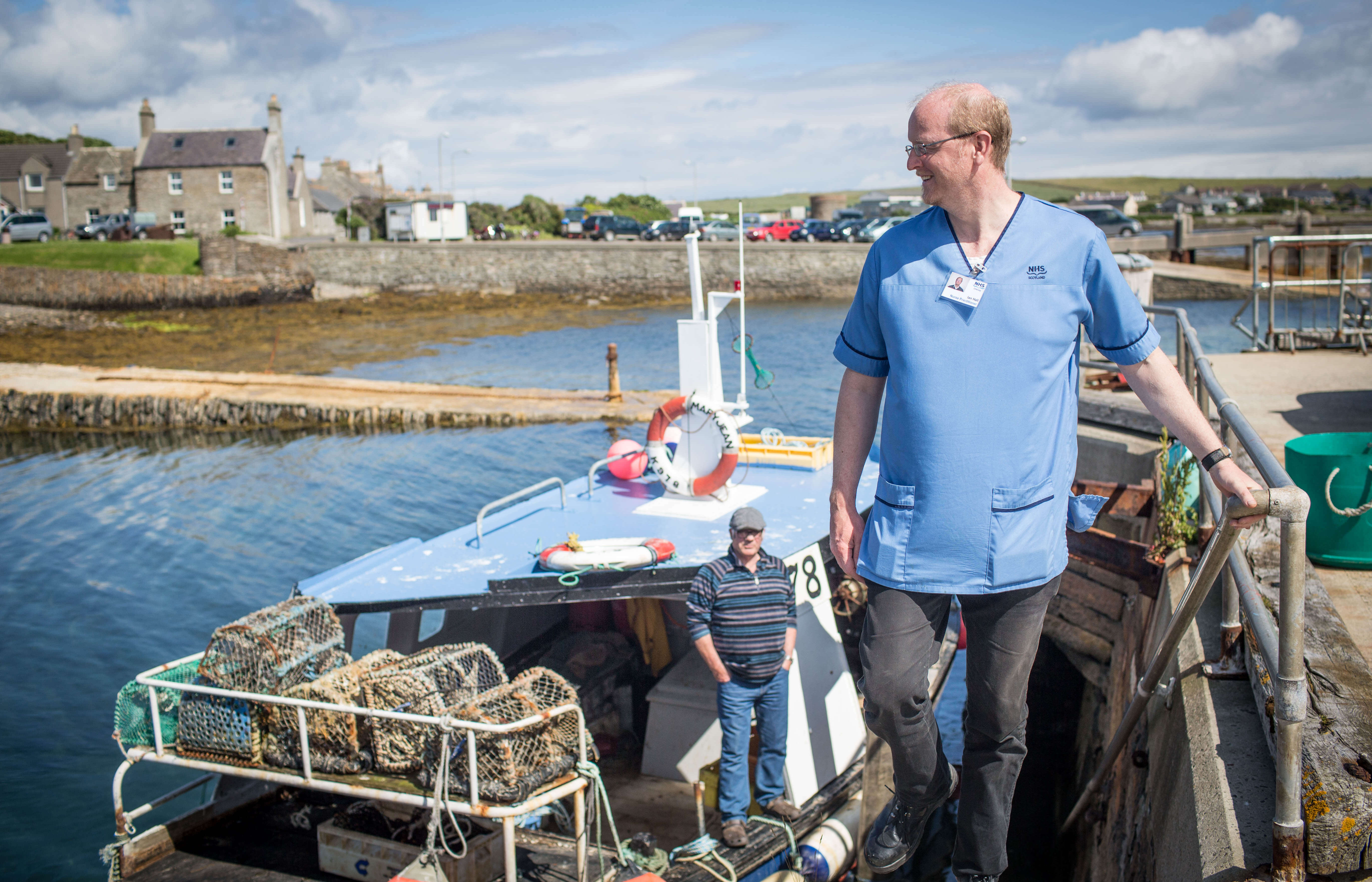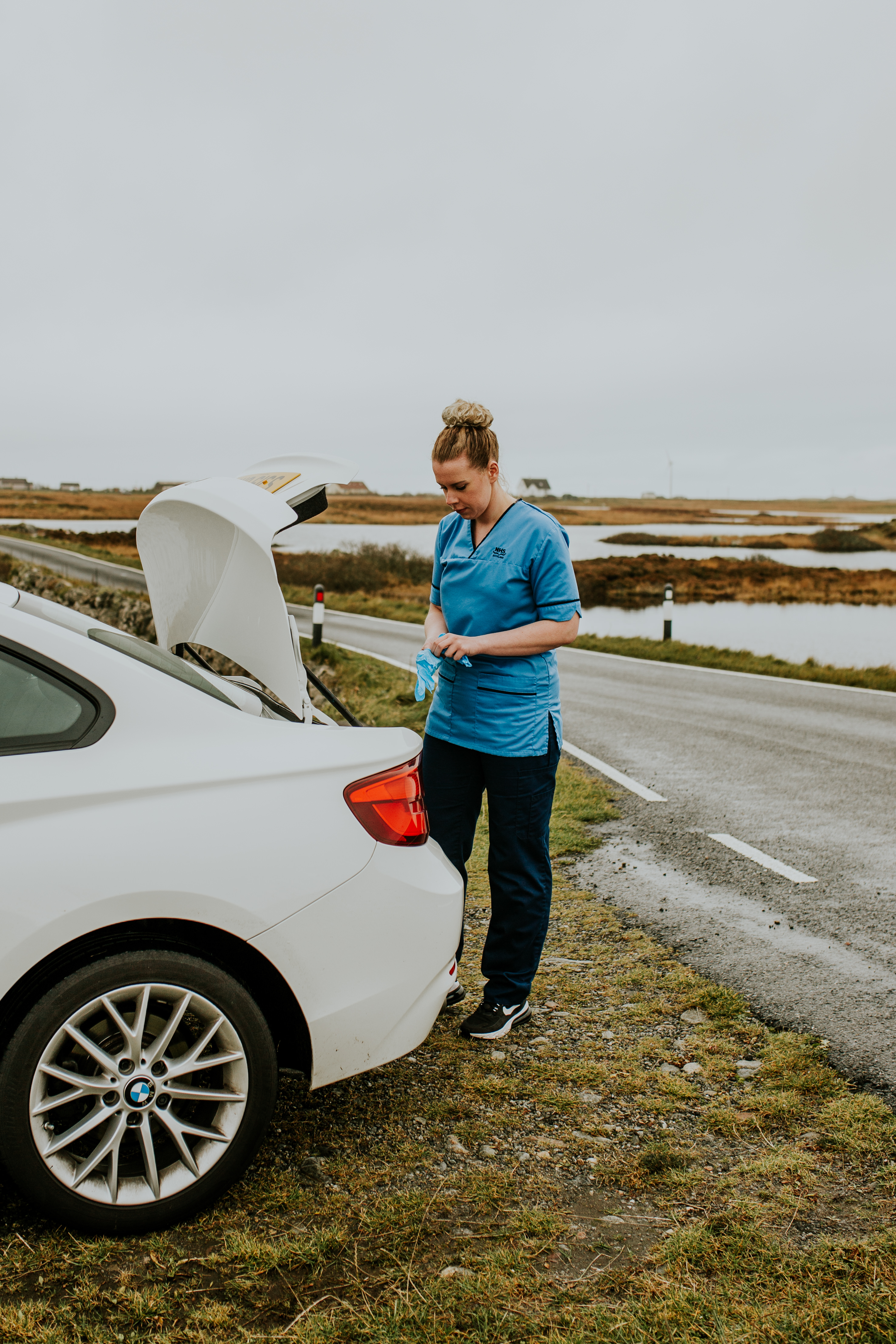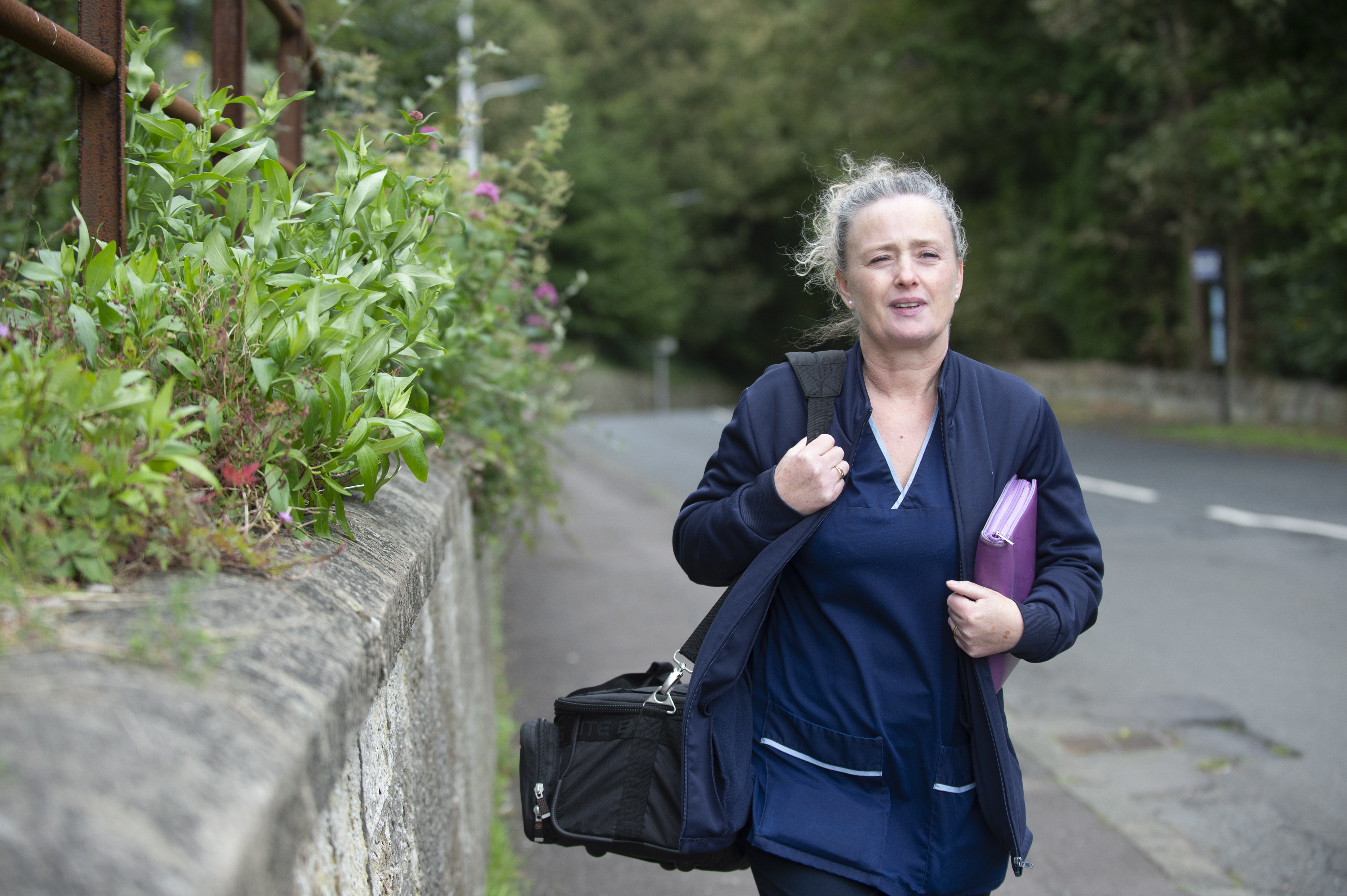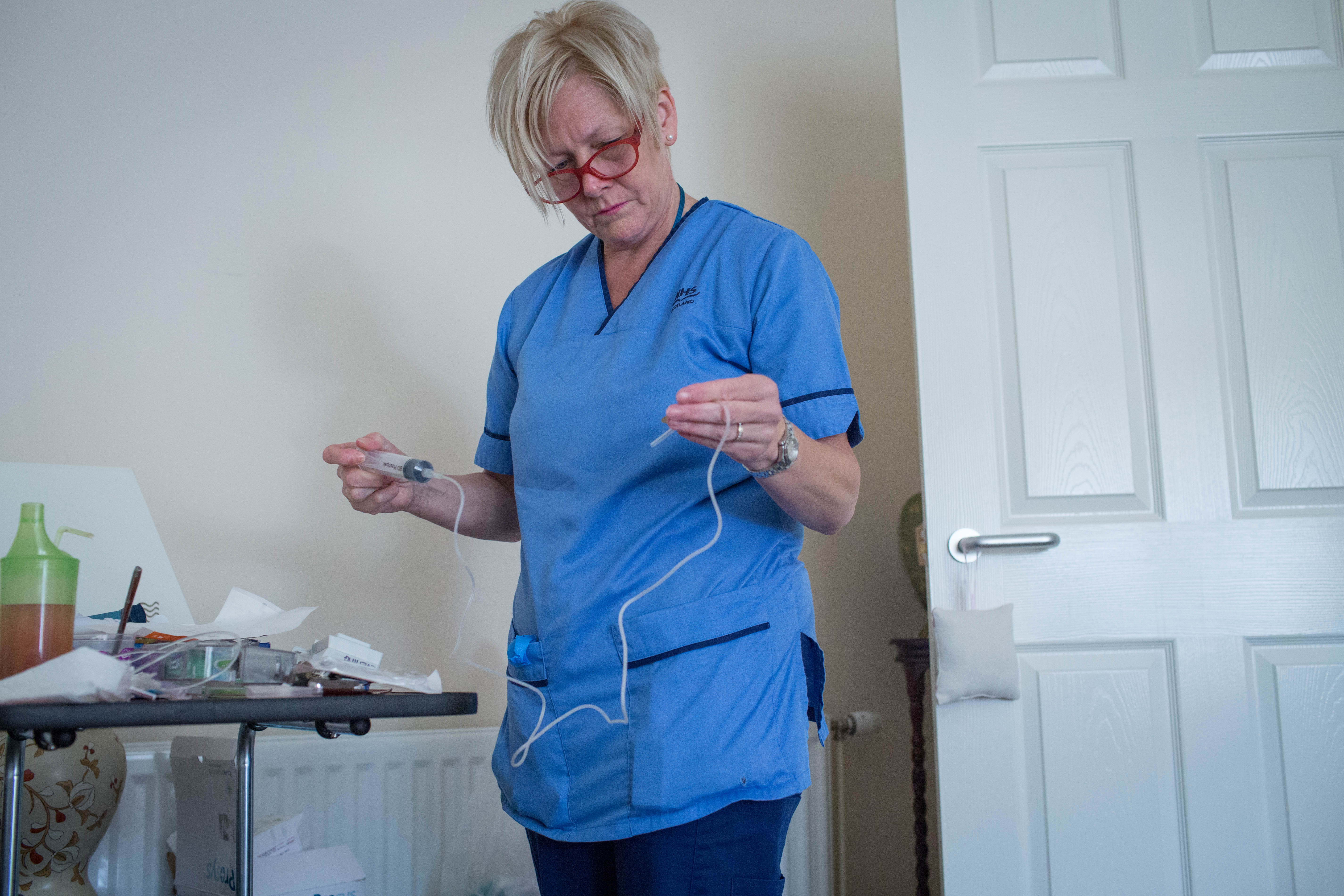
District nurse
District nurses provide care for people at home. They often support people with complex health care needs and facilitate their discharge from hospital, and they provide timely care that prevents the need for admission to hospital in the first place. District nurses assess and manage clinical risks especially where people have deteriorating health, and work closely with multidisciplinary colleagues to enable anticipatory care.
District nurses

Annie Macdonald
Working in the community appealed to me because I wanted to be able to look after people in their own homes. I previously worked in intensive care and thought that I would benefit from an environment where I could provide a more holistic approach toward care. The dynamic is vastly different when you are a guest in someone else’s home, there is a sense that you have been invited into their space. You often meet not just the person receiving care but the whole family. Where I work in the Western Isles, I have even seen lambs and calves coming wandering in and out of the house. District nursing in people’s homes allows you the time and space to take in the bigger picture. You assess an individual while fitting into their routine.
The geography of where I work means that, if at all possible, it is much easier for people to be treated at home. Although there is a hospital on Benbecula, that can be a journey of over 50 miles and specialist care might even involve being flown off the island. If a hospital stay is required, people can find themselves isolated from family. My goal is to reduce the risk of hospital admissions and where unavoidable to arrange for quick and streamlined discharges. The challenges of remote and rural healthcare include linking to community services following a hospital stay. I often arrange contact with the occupational therapist or receiving remote training from the social care workers up on Stornoway. It makes sense for me, as the district nurse, to carry out these arrangements given the logistical difficulties. My day can include everything from baby immunisations to end of life care.
This is a unique and diverse role. You cannot fully prepare yourself for a job as a community nurse and it is not a job that finishes when you walk out the door. Even at the shop, I get called Annie the Barra nurse! It becomes a part of your identity. I like to say that it reflects the area I live in – rural, isolated, and exposed but rewarding. The natural landscape can be rugged, there might be no space for your wound pack or maybe the dog is over-friendly, but you have to get creative and make a clinical surface out of unlikely things.
Since this interview, Annie has taken up a new post as an Advanced Nurse Practitioner with Benbecula Medical Practice.

Mary Kinninmonth
I am a District Nurse Team Leader with NHS Fife covering a large, mainly rural area. As well as the five district nursing teams in the locality, I also line manage an evening nursing service. I hold my own caseload, while supporting charge nurses who manage their own caseloads. Geographically, it is a very wide area to cover which, as a team leader, is quite challenging, just trying to get from one base to another. Healthcare needs are extremely varied, and we care for people across the age spectrum – it definitely keeps the job interesting.
When I was a final year nursing student I had my own small caseload during a community placement, and I absolutely loved it. After qualifying, my initial post was in a day hospital and then in acute surgical. I was seconded to work with the breast specialist team which had a little bit of community in it and it reinforced that the community setting was my end goal. I secured a post as a community staff nurse soon after in 2003 and have been working with district nursing teams ever since. In my first community post, I had a fantastic charge nurse - she was a wonderful role model and really encouraged me to develop further professionally. I undertook the specialist practitioner course in 2011 and worked as a charge nurse until the team leader post I’m now in came up around three years ago. I’ve got the best of both worlds – I am out and about seeing patients but I’m also the team leader, with the opportunity to develop other staff, working with them modelling the behaviours, skills and competencies that support and enable person-centred care in the community.
The complexity of care for patients in the community has increased hugely over the last few years, with significant advances in technology. My expertise is in delivering and coordinating that complex care, working with people their families, carers and the health care team. It means where previously people couldn’t have stayed at home they now can because staff are skilled with specialist knowledge and equipment. As a team leader, I ensure we are developing our workforce so they can meet the needs of these people. It requires the clinical knowledge to manage complex care in the community, and I use my advanced assessment skills to anticipate their needs. A broad knowledge of other agencies is key to look at what services are available to support people. An approachable and confident manner is essential to give people and families confidence in the nursing team. Above all, my clinical skills allow me to make rigorous assessments and to coordinate care. We are highly trained, we are skilled, and we assess risk ensuring that patient safety is at the forefront of everything we do. The bottom line is that people can stay at home with complex symptoms because we can manage people at home now who need a more intensive level of nursing care.
Looking after people at the end of their lives is particularly rewarding. Being able to support people at home, where that is their preference, and manage their symptoms well with their family around them is one of the best parts of being a district nurse. Recently, there was a lady at end-of-life who had expressed her wish to remain at home. This was so important to her as her family would have faced challenges being able to visit her in hospital. I met with her and her relatives soon after her diagnosis, listened to their concerns and hopes for managing her symptoms. The team’s involvement became greater as time went on. We arranged to put the bed and specialist equipment in an area of the house where she really wanted to be. We increased the services needed to support her and her family. She was comfortable, her symptoms were well managed, and she passed away in her home with her loved ones there around her. She had her wish to die at home fulfilled. If she had to go into hospital it would have been a completely different experience for the whole family. That’s what you want to be able to do for everyone – make sure all things are in place to make a difference to them.

Barbara McFadzean
It is 8.30am on a Monday morning, and the members of the district nursing team based at Crosshouse Area Centre in Ayrshire are starting their day. Among the messages left overnight is a call from the daughter of someone who is receiving end-of-life care at home. Her mum has dislodged the syringe delivering pain relief, and help is required. Within minutes, District Nurse Barbara McFadzean is in her car, ready to respond.
“It is our job to make sure that people receive exceptional care at home,” she says. “No one wants to be in hospital if they can help it, and we do everything we can to prevent admission.”
Barbara works in Kilmarnock where her team is aligned to two large general practices covering a mix of rural and urban areas, with pockets of high deprivation. Barbara, alongside five Community Staff Nurses and two healthcare assistants, assume nursing responsibility for lists totalling 20,000 patients.
Nursing people in the community involves providing complex care at home including at end-of-life. Barbara says: “We can be asked to deal with any care situation; we have a high skill set and are experts in delivering holistic care. Daily, we can range from managing long-term conditions to dealing with acute or chronic wounds.
“We also invest a lot of time with people, planning and anticipating their ongoing care needs.”
Barbara does around a dozen home visits over a typical clinical day, as well as liaising with other health professionals and signposting people and relatives to additional services, if required. Her job also involves clinical supervision, caseload management and coordination of care delivery, case reviews, keeping up-to-date with practice and policy changes, recruitment, staffing issues, and rota preparation.
The team also operates treatment room clinics within the GP practice for patients on the caseload who are not housebound but still require wound care, suture and clip removal, bloods to be checked, and injections.
Referrals to the DN team can come from GPs, hospitals, the Allied health team, people themselves and their carers – anyone can call the community nursing team directly. Between them, the nurses here carry an active caseload of around 250 people at any one time and provide services seven days a week.
The East Ayrshire District Nurses mentor and assess nursing students from the University of the West of Scotland and some students from the Open University. “I want the next generation of nurses to see what wonderful professional opportunities the community offers,” says Barbara.
“That way we can carry on developing district nursing and continue to meet more people’s needs at home.”